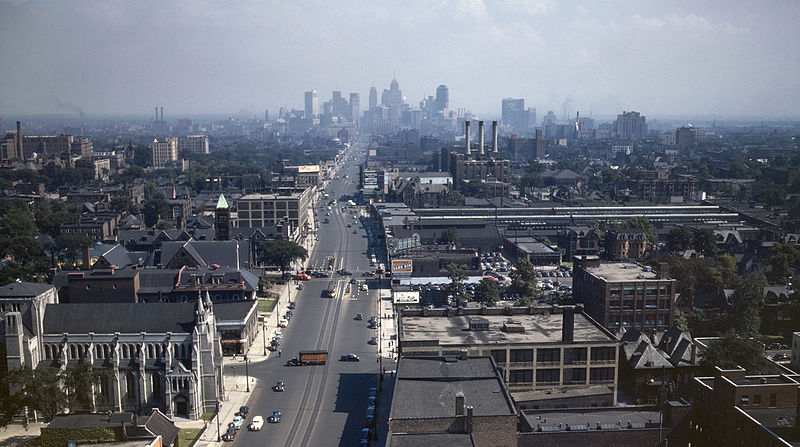Photo: Detroit, 1942 via Wikipedia
After the 1805 fire that left 600 Detroit residents homeless, territorial Judge Augustus Woodward announced he had copied the plans for the soon-to-be-built Washington, D.C., and he would use them to create an even greater city.
That inspired Father Gabriel Richard to bless the plan with the Latin phrase Resuget Cineribus—“It shall Rise from the Ashes”—Detroit’s motto to this day.
But even Father Richard had his doubts: the full motto was prefaced with the phrase Speramus meliora—“We hope for better things.”
Conservatives ignore how Detroit’s troubles date back more than 100 years. There is no single or simple explanation for its many woes, including the one the political right always gets wrong: race.
So it pays to remember that Detroit has a long history of coming up short, especially now that conservatives are using the city’s bankruptcy as their political punching bag: Rush Limbuagh declaring that Detroit is Obama’s master plan for America; Ann Coulter sneering that Detroit’s downfall is due to angry blacks who fed from the public teat; Charles Krauthammer concluding that Detroit provides is proof that to make big cuts in Social Security and Medicare, stat! Then there is Ted Nugent, who took a break from fantasizing on how he wished he had shot Trayvon Martin to declare all liberals as diseased.
They all ignore the many histories of Detroit that have documented how the city’s troubles date back more than 100 years, that there is no single or simple explanation for its many woes, including the one the political right always gets wrong: race.
Ironically, when conservative critics say the riots doomed Detroit economically, they aren’t entirely wrong, they just are using the wrong riot—and if you didn’t know there were three major race riots in Detroit’s history (two started by whites), not to mention an attempt by the Ku Klux Klan to start another riot in 1925, then you have a lot to learn about Motown.
Detroit’s location across the river from Canada made it an important stop on the Underground Railroad, which also made the city’s black population an easy target for white anti-draft rioters in 1863. Later, during the Great Migration of the early 20th century, Southerners of all races moved to the city in search of jobs in the booming auto industry. Yet as the black population grew, so did membership in the Ku Klux Klan.
In 1925, after an African-American doctor moved into a white neighborhood, a Klan-led mob attacked his house. When the doctor shot a man smashing his windows, he was charged with murder. So when famed attorney Clarence Darrow convinced an all-white jury to acquit the doctor, the Klan responded with a cross burning in downtown Detroit attended by thousands. At the burning, the Klan issued a pledge to elect a “white rights” government.
The Klan was able to elect several city politicians, including a mayor in 1930, though he was so corrupt he was recalled after just nine months, but not before he appointed several Klansmen to city agencies. But the election put the Michigan Klan under national scrutiny, especially one branch, known as the Black Legion, whose exploits would inspire a Warner Brothers movie starring Humphrey Bogart.
Yet in the end it wasn’t the Klan but bankers, real-estate companies and city officials that did the most racial damage: documents revealed in a 1970s federal lawsuit that proved the existence of a commercial conspiracy to use mortgages and property development to segregate the city continued until the late 1950s.
And those schemes were possible because public corruption has been rampant in Detroit since the 1920s.
It began with reformers who passed a city charter in 1918. Seeking to end machine politics, they abolished wards in favor of citywide elections for all politicians, which concentrated power with the mayor and the city’s bureaucracy.
It was a disaster: it actually made the political machines and interest groups stronger as the plan effectively barred citizens from electing to city government representatives who were actually came from their own neighborhoods—a problem that continues to this day.
Then Prohibition came and as Daniel Okrent writes in his brilliant book, Last Call: The Rise and Fall of Prohibition, legal loopholes and judicial rulings allowed billions of legal liquor bought in Canada to pass through Detroit. By 1927, selling untaxed liquor became Detroit’s second-largest industry, with estimated sales of $215 million a year.
And bribery was rampant: the books for Canadian distillers showed that they budgeted about $2 million annually to pay for bribes in Detroit.
But the one event that would do the most damage was the 1943 riot: most remember Motown during WWII as the place where the real Rosie the Riveter lived or how Detroit’s manufacturing plants made the munitions that won the war.
Often forgotten was how racial tensions led to rioting in 1943. Despite independent investigations that faulted all sides but found the most of blame lay with the city’s white population, Michigan’s governor and Detroit’s city prosecutor declared the black community was entirely to blame and prosecuted dozens. In the riot’s aftermath, many manufacturers made plans to move their operations after the war.
Thus from 1946 to 1964, more than half of Detroit’s manufacturing base disappeared, taking more than 60 percent of the blue-collar jobs with them. By the time of the 1967 riots, Detroit had been on the decline for 20 years, but revisionist conservatives just ignore that part of the story.
But that’s nothing new: ignoring facts have been a cottage industry in Detroit since 1805.
Peter Lindstrom is a political consultant and researcher. He lives in Washington, D.C.







0 Comments